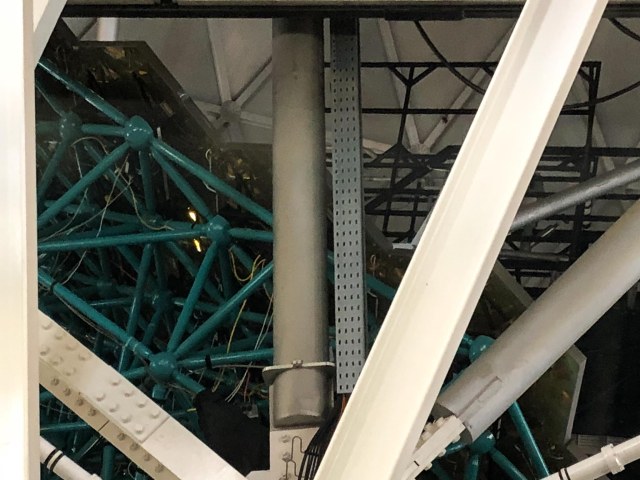On our way to see the George H. W. Bush Library and Museum in College Station, Texas, we made a short detour through Fort Davis, Texas, with the goal of seeing the McDonald Observatory. The Twilight and Star Party programs were sold out so we signed up for the 2:00 p.m. guided tour and solar viewing. After the hour and a half drive and a quick set up at McMillen’s RV Park, we were off to see the show.

McDonald Observatory is part of the University of Texas in Austin and open to the public daily for guided tours and solar viewing. Star Parties and Twilight programs are offered on Tuesday, Friday, and Saturday night when visitors can observe constellations and celestial objects through a number of telescopes in the Rebecca Gale Telescope Park.
The quick meal we ate at the StarDate Cafe was surprisingly good. While we waited for the tour to begin we wandered around outside and enjoyed the view.


The tour started with a lecture in an auditorium. The tour guide who gave the lecture talked so fast using stats and terminology beyond my comprehension that Jon had to nudge me before I fell asleep. It reminded me of being in a lecture hall in college. I wanted my notebook and pen to take notes and stay awake. The guide included views of solar activity from different locations around the world. Too bad the sun did not cooperate by displaying its spectacular solar flares. Although the sun activity was relatively calm, it was still interesting to see the views on the screen.
Mount Locke’s summit at an elevation of 6,791 has some of the darkest night skies making it an ideal location for monitoring celestial objects. The valley below is at an elevation of 5,280 feet.

After the lecture, we all hopped in our vehicles and drove to the 107-inch Harlan J. Smith Telescope (constructed in 1968 by Westinghouse for about $5 million). The fresh air and climb up 70 steps to the top floor swept my drowsiness away.
While there, the tour guide explained the various components of the telescope, and how it was constructed. Then he showed how the top part of the building turned on steel wheels on a track rather than tires. Tires would not work for this telescope that weighs 160 tons.

Climbing up a ladder to view the sky through an eyepiece is not needed for this telescope. The view is transmitted to a computer and displayed on a monitor. The computer also collects data used by astronomers for their research.

The Smith Telescope has been used to study “the compositions of stars, the motions of galaxies, and to search for planets around other stars in our galaxy,” so says the observatory’s website.

We then toured the Hobby-Eberly Telescope. The 11-meter (433-inch) mirror “is one of the largest optical telescopes designed for spectroscopy, the decoding of light from stars and galaxies to study their properties.”

The mirror is built in a honeycomb consisting of 91 hexagonal mirrors requiring each mirror to align exactly to form a reflecting surface. This telescope is currently the third largest in the world. Although the mirror segments form a reflecting surface of 11 by 10 meters, only 9.2 meters are used at any given time. Three instruments are used with the telescope: The Marcario Low-Resolution Spectrographs, a Medium-Resolution Spectrograph, and a High-Resolution Spectrograph.

Other telescopes at the observatory include the Otto Struve Telescope (completed in 1938 and used to discover Uranus’ fifth moon Miranda, Neptune’s second largest moon Nereid. It was also used in the discovery of carbon dioxide in Mars’s atmosphere and methane in Saturn’s giant moon Titan’s atmosphere. The 0.8-meter Telescope (the smallest telescope at McDonald Observatory) is used for large search and survey projects, and the 0.9-meter Telescope, built in 1956, is used during the Special Viewing Nights.
For more information regarding the McDonald Observatory visit the website here. Plan ahead and make reservations for one of the Star Party events. They sound like fun.
Safe Travels

beautiful views from the top…great photos of the telescope. I’ve been to Kitt Peak in Arizona, build on a mountain peak sacred to the hosting tribe.
LikeLiked by 1 person
Thanks, Michael. Mother Nature made a beautiful view for me to capture. We have so many places in Arizona to explore.
LikeLiked by 1 person
Wow, great photos of the telescope, Linda!! LOL you almost feel asleep during the presentation.
LikeLiked by 1 person
Thanks, Julaina. Yep. I had a hard time paying attention and my eyelids had trouble staying open.
LikeLiked by 1 person
That should be a great experience 🙂
LikeLiked by 2 people